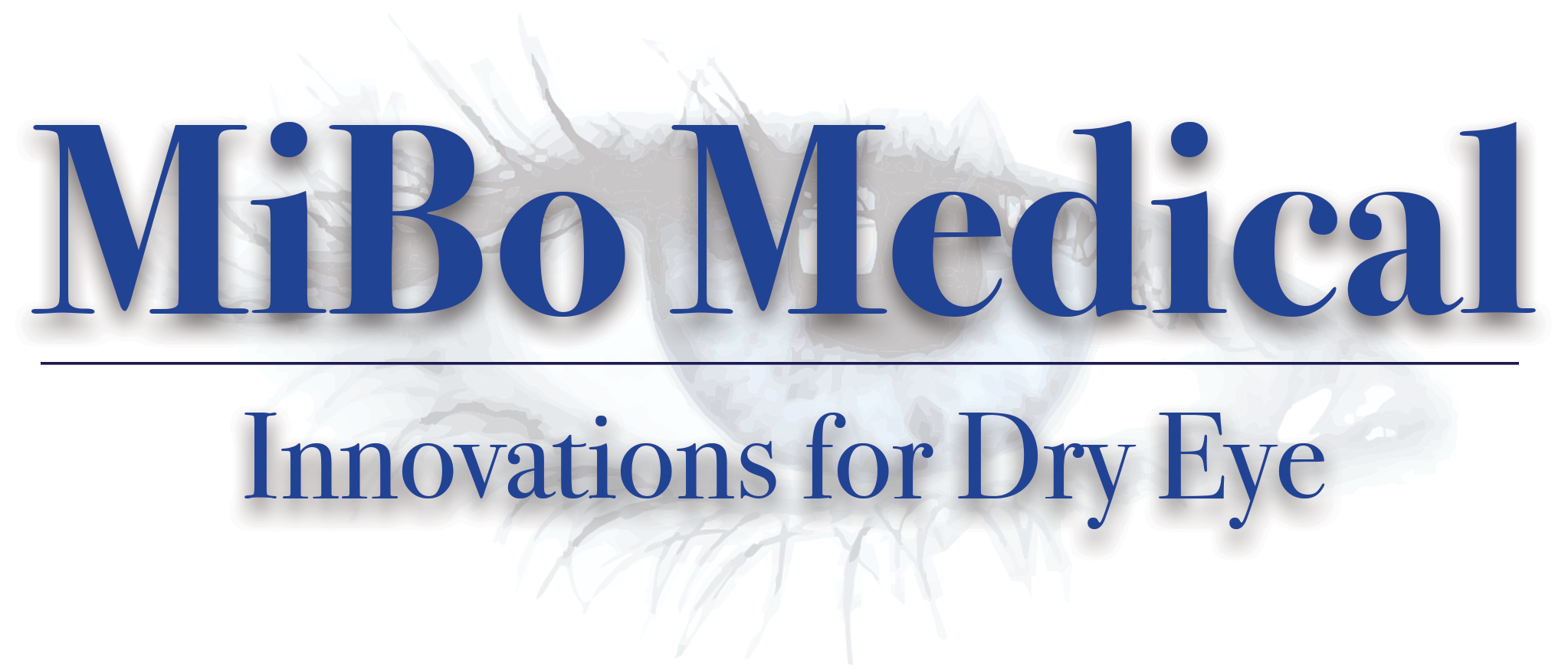Clinical Research
Research Articles
New, Targeted Technology for Treating the Root Cause of Dry Eye Disease (DED)
MiBo ThermoFlo (PainPoint Medical Systems) is new technology targeted at treating the root cause of lipid-deficient dry eye disease (DED): a poor lipid layer resulting from an insufficient amount of meibum secreted onto the ocular surface. MiBoFlo uses thermoelectric heat via a handheld probe that has a double eye pad attached with ultrasound gel applied to the end to facilitate the heat transfer through the lid to the meibomian glands.
Heat at a temperature of 108° is emitted from the probe. A technician can easily massage the lids with the probe alternating between a circular and back and forth motion.
In my colleagues and my DED clinic, we have developed a specific protocol for treatment, which works very effectively. We perform three consecutive treatments. The first is 12 minutes per lid, the second is performed 1 week later and lasts 10 minutes per lid, and the third is performed 2 weeks later and lasts 8 to 10 minutes per lid.
We charge $450 for all three treatments, and it is an out-of-pocket expense for the patient. There are no disposable eye pieces or activators necessary, allowing the cost to patients to be minimum. In our experience, patients are very receptive to the treatment and the cost is not prohibitive.
Additionally, we strongly recommend that patients also begin a regimen of the triglyceride form of omega-3 supplements, such as Dry Eye Omega Benefits from Physicians Recommended Neutriceuticals, at a 2,300-mg dose. The healthier meibum combined with the heat treatment and better meibum flow lends to excellent results in our experience. We make these treatments available in a spa-like environment with music and a special pillow, which makes it a great experience for the patient.
We have preliminary data from a 51-patient study which they underwent three treatments as per our protocol. We evaluated Schirmer tests, tear breakup time (TBUT), osmolarity, and both Ocular Surface Disease Index (OSDI) and Standard Patient Evaluation of Eye Dryness (SPEED) scores at baseline, 1 month, 2 month and 4 months after treatment. At the 4-month, visit TBUT, osmolarity, OSDI and SPEED scores all showed statistically significant improvement.
Our clinic utilizes both the LipiFlow (TearScience) and MiBoFlo technology. We have found that the latter gives patients an almost immediate improvement in their symptoms after their first treatment, where in our experience, LipiFlow may take 6 weeks. Many patiens appreciate the cost benefit of not having to pay for the disposable activators.
We offer MiBoFlo as a first-line treatment for our lipid-deficient DED patients, combined with the triglyceride form of omega-3s and lipid-based artificial tears. We have had success in patients with meibomian gland dysfunction, meibotitis, and posterior blepharitis. We have also treated pre- and post-LASIK patients, those becoming contact lens intolerant, and patients with acute hordeolum.
CONCLUSION
While practices struggle to find alternate revenue streams, we have found that aggressively treating DED and incorporating MiBoFlo in a successful practice builder.
Founder and medical director of Hazleton Eye Specialists, Stroudsburg Eye Specialists and The Dry Eye Clinic of Northeast, PA
foreyeys@ptd.net
Acknowledged no relevant financial interest
Sidebar: Therapeutic Device for DED Treatment Uses Thermoelectric Heat
Cataract and refractive surgeons have recognized that their success in the OR depends on the effective management of dry eye disease (DED). The media, once enamored with LASIK, directs most of its attention to a so-called epidemic of DED. The condition has cost LASIK surgeons hundreds of potential candidates and thousands of hours of needless chair time.
Thermal punctal occlusion and later temporary and semipermanent occlusion were breakthrough techniques decades ago. Optometry and ophthalmology quickly embraced this definitive, affordable, and effective treatment. Topical cyclosporine, an antiinflammatory medication known for its use in high-risk keratoplasty, was reborn as Restasis (cyclosporine ophthalmic emulsion 0.05%; Allergan) and became the first pharmacologic weapon against DED.
Rolando Toyos, MD, released his outstanding results with intense pulsed light (IPL), and I have confirmed its effectiveness in my practice during the past 3 years.1 Dr. Steven Maskin’s probing technique has brought relief to many.2 The LipiView Ocular Surface Interferometer (TearScience), designed by physician-scientist Donald Korb, assesses the quality of the blink reflex and the central corneal lipid layer thickness.3 Its companion device, the LipiFlow Thermal Pulsation System, delivers pulsated heat and compression to the root cause of meibomian gland dysfunction.4
Mike Whitehurst from Pain Point Medical showed me a diminutive and user-friendly device called MiBoFlo. It uses a modest amount of AC current and an embedded computer to consistently warm a silver tab-shaped probe tip to 108˚F. This applicator can warm, massage, and empty clogged meibomian glands during a technician-performed 20-minute session. The tips are removable and sterilizable, and there are no consumables.
During the past 6 months MiBo, has been updated with newer handpieces and probe tips, an improved treatment protocol, and other innovations. When I see a pre- or postsurgical patient with significant meibomian gland disease, I schedule a MiBo treatment knowing I can eat the cost if a patient cannot or will not pay. Patients view MIBO as a true medical intervention and have asked to see my technician directly for the treatment. I am aware of other users charging $100 to $200 a session, often in packages of four. This covers the cost of the unit in a few months.
I use the device as a definitive treatment for evaporative dry eye, either alone or as a supplement to LipiFlow and/or IPL. Preoperatively, I use it to treat LASIK and premium IOL patients whenever there is significant meibomian gland dysfunction. Postoperative patients with surface issues, including transplant patients, benefit from therapy. I have used MiBo to address hordeolum with great success.
I distributed questionnaires to my first 100 MiBo patients, some who were new dry eye referrals and others who had been treated with LipiFlow, IPL, plugs, and Restasis in my practice. At 1 month, 86% felt some level of symptom relief. I believe this technology is an inexpensive and effective addition to any practice trying to treat the more than 23 million individuals who suffer from DED in the United States.5
James S. Lewis, MD, is in private practice in Elkins Park, Pennsylvania.
He acknowledged no financial interest in the products or company mentioned herein.
Dr. Lewis may be reached at jslewis@jameslewismd.com.
Toyos Clinic website. Intense Pulse Light: For Treating Dry Eye. http://www.toyosclinic.com/procedures/dry-eye-syndrome/ toyos-optimum-ipl-dry-eyes. Accessed May 12, 2014.
Maskin SL, Kantor K. Intraductal meibomian gland probing to restore gland functionality for obstructive meibomian gland dysfunction. http://drmaskin.com/includes/meibomian-probing.pdf. Accessed May 12, 2014.
Finis D, Pischel N, Schrader S, Geerling G. Evaluation of lipid layer thickness measurement of the tear film as a diagnostic tool for meibomian gland dysfunction. Cornea. 2013;32(12):1549-1553.
Korb DR, Blackie CA. Case report: a successful LipiFlow treatment of a single case of meibomian gland dysfunction and dropout. Eye Contact Lens. 2013;39(3):e1-3.
The epidemiology of dry eye disease: report of the Epidemiology Subcommittee of the International Dry Eye WorkShop (2007). Ocul Surf. 2007;5(2):93-107.
How We Built a Dry-Eye Niche that Generates $250,000+ Annually
By Eric Rettig, OD June 19, 2019

Dry eye is an increasingly common condition, with the growing elderly population and ever-heavier use of digital devices. Here’s how my four-OD, 26-support staff practice has made diagnosing and serving these patients a revenue growth area.
We see 50-75 dry eye patients a week. That number has definitely grown in the past five years. A large part of this growth has been point-of-care testing that helps with diagnosis the day the patient is here, as well as the newer and more available treatment options we have. In addition, patients are much more aware of the disease now than they were five years ago, so they often ask about the symptoms of dry eye themselves.
Our practice generates over $250,000 annually from dry eye. This number has gone up each year over the past five years, and we expect that number to continue to grow. Revenues per patient visit generate anywhere from $120 to $400 depending on the services provided
 Start Small & Grow Services
Start Small & Grow Services
We started with offering tear osmolarity testing with TearLab and then added Inflammadry. We’ve also purchased a meibographer to help assess the meibomian glands. The images are great for patient education. Last year we added the MiBo Thermoflo to our practice, which so far patients have responded well to.
In our area, in upstate Pennsylvania, this instrument made the most sense financially, as we wanted to be able to keep these treatments affordable to nearly everyone, while also not being a huge financial burden for us. The doctors in our practice and our patients are liking the results. We also do a lot of punctal occlusion in our practice, which is great for patients who have difficulty with compliance for artificial tears or other medications that treat poor tear production.
In addition, we use amniotic membranes to treat some severely dry patients. These are patients who often have systemic issues causing their dry eye to worsen and have trouble getting relief from other therapies. Amnion helps to rejuvenate the ocular surface and kick-start healing. Amniotic membranes aren’t used all the time, but they are a great tool for difficult cases, as well as another revenue stream.
Set Aside Needed Chair Time
Needed time for patients varies, but for most cases, there isn’t a lot of chair time needed. This is something I like about managing dry eye. Patients can be seen at any time of day, and even between comprehensive examinations. I spend a few minutes discussing the patient’s symptoms and concerns and then I examine their eyes and analyze data obtained during pre-testing (our staff is trained to get a TearLab and Inflammadry on every dry eye patient).
I discuss treatment options with the patient and what I feel will work best for them, and then prescribe a treatment. This takes no more than 10 minutes total for me, and any other tasks are handled by my staff. The doctors do not need to perform the MiBoThermoflo, and don’t even need to be in the office when the patient comes in for their treatment. Our patients receive a series of four treatments over a six-to-eight week period and then are scheduled for a follow-up visit with the doctor.
We don’t have specific days or time slots devoted only to seeing dry-eye patients, but we do have specific scheduling times for MiBo Thermoflo treatments. We set aside a few times each week during which patients can come in to have those treatments done. We do this because the treatments can take between 20-30 minutes, and we also want to make sure we have a room available for the treatments.
Provided Needed Support-Staff Training
We train our staff to gather information and take a good history, which is vital to finding dry-eye patients. They will also perform point-of-care testing based on patients’ chief complaints and at follow-up appointments. Many of our staff members are trained in how to perform a MiBo Thermoflo on a patient, and we have a dedicated staff member for those treatments.
Educate Patients
Education is definitely necessary for patients, as many don’t realize the symptoms they describe are related to dry eye. I always try to explain things to them using an example from their life that they would be familiar with.
For instance, for something as simple as using artificial tears regularly, I use the example of changing your oil in your car. You don’t change your oil when you start to have problems, you do it regularly to avoid problems; same goes for artificial tears. If you only use them when your eyes feel dry, then there is always going to be a point that they feel dry, but if you get in the habit of using them on a regular basis, you can avoid having those symptoms.
Another example is explaining how punctal plugs work. I use the analogy of the lacrimal system as a sink and faucet. The lacrimal gland is like a faucet and the puncta/lacrimal system is the drain. We use plugs to slow down the drainage of tears.
Play Videos About Dry Eye in Your Reception Area
We do internal marketing of our dry-eye services in our office on TVs we have displayed in the reception areas. The segments we play provide information about new treatments we have to offer. They also help “plant the seed” of dry-eye knowledge in patients who may not have considered it a possible cause of their visual symptoms, encouraging them to ask the doctor about it.
![]() Eric Rettig, OD, is a partner with Mountain View Eye in Altoona, Penn.
Eric Rettig, OD, is a partner with Mountain View Eye in Altoona, Penn.
Benefits for pre LASIK Using the MiBo Thermoflo
by James S. Lewis, MD
- Reduce bacterial load associated with MGD
- Reduce desquamated skin cells and debris
- Reduce inflammation by clearing obstructed glands (pre hordeolum)
- Improve lipid layer of tear film making surface more amenable for flap
- Creation without epithelial injury
- More effective antiseptic preparation for surgery (the prep)
- Reduce risk of DLK from excess proteins, debris, or thickened secretion
- Reduce risk of infection
- Enhance tear film with less early dry eye and visual reduction and fluctuation
- Enhanced comfort from an improvement in tear film
- Less incentive to rub eye and wrinkle flap
- Safely delay normal lid hygiene until flap stabilizes.
